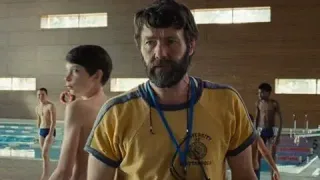January 14, 2025
Review: Front Porch and SpeakEasy Collaborate on Punchy, Powerful 'Ain't No Mo'
Kilian Melloy READ TIME: 3 MIN.
Spoiler Alert: This review contains mention of plot points and other potential spoilers.
"Ain't No Mo,'" a funny, fast-paced, highly satirical, utterly irreverent, and sometimes brutally shocking play by queer playwright Jordan E. Cooper, was nominated for multiple Tony Awards in 2022. The production, now playing at the Boston Center for the Arts – a collaboration between The Front Porch Arts Collective and SpeakEasy Stage Company, directed by Dawn M. Simmons – makes it easy to see why. Cooper precisely dissects America's stubborn institutional racism (a national trait that has recently taken to the denial of its own existence) and finds uproarious humor in its absurdities and gut-punch pathos in the staggering, and ongoing, havoc it wreaks.
The play is structured like a sketch comedy show in which the punch lines are all emotional hammer blows to the gut: A church service lays to rest a man called "Brother Right to Complain," with the preacher joyously describing what America will be like under the leadership of incoming president Barack Obama... until a barrage of news reports about police shootings of Black Americans by police wash away all jubilation.
At another juncture, a woman waiting to be called at an abortion clinic argues with her husband, who pleads for her to carry the child to term. She refuses: To her, terminating the pregnancy is the more honest way of sparing the child. "I don't want to keep my son's body warm when the neighbors are standing around taking pictures and videos for the local news to play on a cycle until it decides to run out of breath," she declares, before adding: "If this country doesn't drink their blood fast enough, they steal the cup right from under it's mouth and drink each other's blood."
That wrenching speech still echoes in the audience's ears as a reality show taping – "Real Baby Mamas of the South Side" – devolves into name-calling around the identity of a "trans" cast member... trans, that is, in the sense that she claims to be transracial. "Yes, I do want your lips," she declares, "I do want your ass, and I do want your hair.... I want it," she concludes her catalogue of appropriation, "and I will fucking have it because I have every right to!"
That question of rights – who has them, who forfeits them, and who pays the bill for them – is the bedrock on which the play is built. Over all else in the show there looms the impending expulsion of all people of color from the United States, with Black Americans given the freedom of strictly limited choices: Either accept a free ticket to Africa, or stay in the U.S. and be transformed into a white person. The history, culture, dignity, and agency of an entire demographic faces obliteration – a situation that finds an apt metaphor in a long-jailed woman crying out for everything she had when she was booked into prison to be returned before she goes free.
The play's vignettes call to mind sketch comedy shows, but hints of magical realism nudge the work into a fantastical plane of existence. The dedicated cast – Schanaya Barrows, Dru Sky Berrian, Maconnia Chesser, Grant Evan, De'Lon Grant, and Kiera Prusmack – all play multiple roles, portraying wild energy as well devastating loss with absolute conviction, and that gives the play cohesion and makes it work. Rather than a scattershot collection of pointed observations, the play gels into a unified, escalating experience of fraught emotion.
"Ain't No Mo'" continues through Feb. 8 at the Stanford Calderwood Pavilion at the Boston Center for the Arts. For tickets and more information, follow this link.






